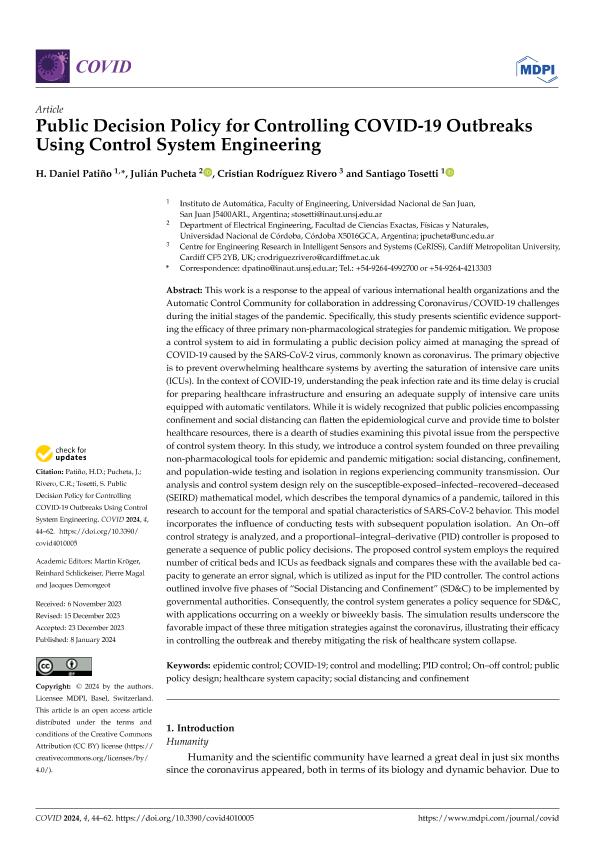Mostrar el registro sencillo del ítem
dc.contributor.author
Patiño, Héctor Daniel

dc.contributor.author
Pucheta, Julián Antonio

dc.contributor.author
Rivero, Cristian Rodríguez
dc.contributor.author
Tosetti Sanz, Santiago Ramon

dc.date.available
2024-03-25T13:48:49Z
dc.date.issued
2023-12
dc.identifier.citation
Patiño, Héctor Daniel; Pucheta, Julián Antonio; Rivero, Cristian Rodríguez; Tosetti Sanz, Santiago Ramon; Public Decision Policy for Controlling COVID-19 Outbreaks Using Control System Engineering; MDPI ; COVID; 4; 12-2023; 44-62
dc.identifier.issn
2673-8112
dc.identifier.uri
http://hdl.handle.net/11336/231466
dc.description.abstract
This work is a response to the appeal of various international health organizations and the Automatic Control Community for collaboration in addressing Coronavirus/COVID-19 challenges during the initial stages of the pandemic. Specifically, this study presents scientific evidence supporting the efficacy of three primary non-pharmacological strategies for pandemic mitigation. We propose a control system to aid in formulating a public decision policy aimed at managing the spread of COVID-19 caused by the SARS-CoV-2 virus, commonly known as coronavirus. The primary objective is to prevent overwhelming healthcare systems by averting the saturation of intensive care units (ICUs). In the context of COVID-19, understanding the peak infection rate and its time delay is crucial for preparing healthcare infrastructure and ensuring an adequate supply of intensive care units equipped with automatic ventilators. While it is widely recognized that public policies encompassing confinement and social distancing can flatten the epidemiological curve and provide time to bolster healthcare resources, there is a dearth of studies examining this pivotal issue from the perspective of control system theory. In this study, we introduce a control system founded on three prevailing non-pharmacological tools for epidemic and pandemic mitigation: social distancing, confinement, and population-wide testing and isolation in regions experiencing community transmission. Our analysis and control system design rely on the susceptible-exposed?infected?recovered?deceased (SEIRD) mathematical model, which describes the temporal dynamics of a pandemic, tailored in this research to account for the temporal and spatial characteristics of SARS-CoV-2 behavior. This model incorporates the influence of conducting tests with subsequent population isolation. An On?off control strategy is analyzed, and a proportional?integral?derivative (PID) controller is proposed to generate a sequence of public policy decisions. The proposed control system employs the required number of critical beds and ICUs as feedback signals and compares these with the available bed capacity to generate an error signal, which is utilized as input for the PID controller. The control actions outlined involve five phases of ?Social Distancing and Confinement? (SD&C) to be implemented by governmental authorities. Consequently, the control system generates a policy sequence for SD&C, with applications occurring on a weekly or biweekly basis. The simulation results underscore the favorable impact of these three mitigation strategies against the coronavirus, illustrating their efficacy in controlling the outbreak and thereby mitigating the risk of healthcare system collapse.
dc.format
application/pdf
dc.language.iso
eng
dc.publisher
MDPI
dc.rights
info:eu-repo/semantics/openAccess
dc.rights.uri
https://creativecommons.org/licenses/by/2.5/ar/
dc.subject
EPIDEMIC CONTROL
dc.subject
COVID-19
dc.subject
CONTROL AND MODELLING
dc.subject
PID CONTROL
dc.subject
ON?OFF CONTROL
dc.subject
PUBLIC POLICY DESIGN
dc.subject
HEALTHCARE SYSTEM CAPACITY
dc.subject
SOCIAL DISTANCING AND CONFINEMENT
dc.subject.classification
Sistemas de Automatización y Control

dc.subject.classification
Ingeniería Eléctrica, Ingeniería Electrónica e Ingeniería de la Información

dc.subject.classification
INGENIERÍAS Y TECNOLOGÍAS

dc.title
Public Decision Policy for Controlling COVID-19 Outbreaks Using Control System Engineering
dc.type
info:eu-repo/semantics/article
dc.type
info:ar-repo/semantics/artículo
dc.type
info:eu-repo/semantics/publishedVersion
dc.date.updated
2024-03-25T12:24:37Z
dc.journal.volume
4
dc.journal.pagination
44-62
dc.journal.pais
Suiza

dc.description.fil
Fil: Patiño, Héctor Daniel. Consejo Nacional de Investigaciones Científicas y Técnicas. Centro Científico Tecnológico Conicet - San Juan. Instituto de Automática. Universidad Nacional de San Juan. Facultad de Ingeniería. Instituto de Automática; Argentina
dc.description.fil
Fil: Pucheta, Julián Antonio. Universidad Nacional de Córdoba. Facultad de Ciencias Exactas, Físicas y Naturales; Argentina. Consejo Nacional de Investigaciones Científicas y Técnicas; Argentina
dc.description.fil
Fil: Rivero, Cristian Rodríguez. Cardiff Metropolitan University; Reino Unido
dc.description.fil
Fil: Tosetti Sanz, Santiago Ramon. Consejo Nacional de Investigaciones Científicas y Técnicas. Centro Científico Tecnológico Conicet - San Juan. Instituto de Automática. Universidad Nacional de San Juan. Facultad de Ingeniería. Instituto de Automática; Argentina
dc.journal.title
COVID
dc.relation.alternativeid
info:eu-repo/semantics/altIdentifier/url/https://www.mdpi.com/2673-8112/4/1/5
dc.relation.alternativeid
info:eu-repo/semantics/altIdentifier/doi/http://dx.doi.org/10.3390/covid4010005
Archivos asociados
